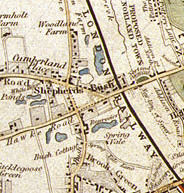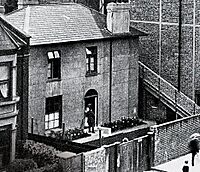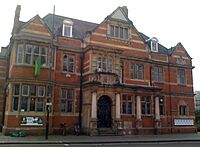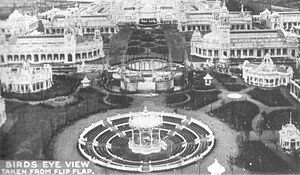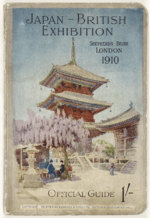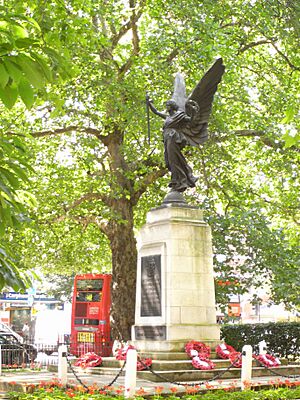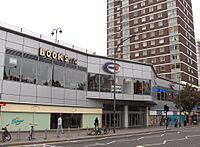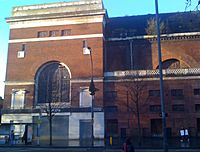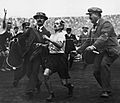History of Shepherd's Bush facts for kids
Shepherd's Bush is a lively area in West London, part of the London Borough of Hammersmith and Fulham. It's built around a large green space called Shepherd's Bush Green. Long ago, this area was a pasture where shepherds rested their sheep on their way to market. In the late 1800s and early 1900s, it grew into a busy neighbourhood.
The arrival of railways in the mid-1800s, like the West London Railway in 1844 and the Metropolitan Railway in 1864, helped Shepherd's Bush grow. More people moved here, and businesses opened. In 1903, the famous Shepherd's Bush Empire music hall opened, where even Charlie Chaplin performed when he was starting out!
A big moment for Shepherd's Bush was in 1908 when it hosted parts of the 1908 Summer Olympics. That same year, it held the huge Franco-British Exhibition, also known as "The Great White City." This fair attracted 8 million visitors and celebrated the friendship between the UK and France. More exhibitions followed until World War I began in 1914.
In 1915, the Gaumont Film Company built Lime Grove Studios, the first building in the UK made just for making films. Later, the BBC used these studios for many years. During World War II, the area was bombed, especially by V-weapons. After the war, new roads like the Westway were built, changing the area and replacing some older homes.
In 2008, the massive Westfield London shopping centre opened on the site of the old exhibition grounds. It became one of the biggest shopping centres in London.
Contents
Where Did the Name Come From?
The exact reason for the name Shepherd's Bush isn't fully known. It might come from the area being a resting spot for shepherds taking their sheep to Smithfield Market in London. There's a story that shepherds used to trim a hawthorn bush to create a shelter from the weather while they watched their flocks. Another idea is that the area was simply named after a local landowner. The name "Sheppards Bush Green" was first written down in 1635.
People have lived here since the Iron Age. Shepherd's Bush first appeared in official records in 704 AD when the Bishop of London, Waldhere, bought it as part of a larger estate. For a long time, it wasn't a very important place. However, in the mid-1600s, a cottage on Goldhawk Road became home to Miles Sindercombe. He was a disgruntled soldier who tried to assassinate Oliver Cromwell in 1657. His plan failed, and he was sentenced to death, but he avoided execution by taking poison. His cottage was later pulled down in the 1760s.
An old map from the 1700s by John Rocque shows Shepherd's Bush as mostly countryside, with only a few buildings around the Green. But the main roads, like the "North High Way" (now Uxbridge Road) and Turvens Lane (now Wood Lane), were already there, much like today.
The 1800s in Shepherd's Bush
A map from 1841 shows Shepherd's Bush was still mostly farmland, with fewer buildings than nearby Hammersmith. There were also several small lakes. Buildings were mostly found along the main roads like Wood Lane, Uxbridge Road, and Goldhawk Road.
By the 1860s, the expansion of railways meant that the fields of Shepherd's Bush would soon be replaced by houses.
In the 1870s, private companies started running tram services in Shepherd's Bush. Trams were smoother and more comfortable than horse-drawn buses. In 1901, electric trams began to replace horse-drawn ones. Many different private companies ran these services until 1933, when most of London's transport companies joined together under the London Passenger Transport Board.
The West London Railway opened in 1844, running north to south, east of Shepherd's Bush Green. It wasn't very successful at first and even closed for a short time.
The Metropolitan Railway opened its own Shepherd's Bush station in 1864. This station was near the Shepherd's Bush Market area.
Growing into a Town
Shepherd's Bush really started to grow with new homes in the late 1800s as London's population increased. St Stephen's, an Anglican church, was built around 1849-1850.
In 1895, the Passmore Edwards Public Library opened on Uxbridge Road. It was paid for by a kind journalist named Passmore Edwards. Today, this building is a theatre.
The Shepherd's Bush Village Hall opened in 1898, and the DIMCO buildings were built. These red brick buildings were originally a shed for a London Underground power station, which was Europe's first electricity generating facility.
Towards the end of the century, many residential streets were built for middle-class families. Hopgood Street, for example, is a typical street of four-storey brick Victorian houses, finished around 1899.
The 1900s in Shepherd's Bush
Building continued quickly in the early 1900s, and entertainment venues soon followed. In 1903, the Shepherd's Bush Empire was built. It hosted music-hall shows with variety acts and revues until the 1950s. In 1910, the Palladium opened nearby, originally a cinema. It closed in 1981 but the building is still there as a pub today.
In 1904, the Catholic Church of Holy Ghost and St Stephen was completed. It was built for the many new residents, including Irish workers who came to London for jobs.
The Underground Arrives
In 1900, the Central London Railway (CLR) opened its Shepherd's Bush station, which is now the Central line station. The Prince of Wales (who later became King Edward VII) officially opened the line. The CLR was known as the Twopenny Tube because of its cheap fare. Its tunnels and stations now form the central part of the London Underground's Central line.
For 108 years, until 2008, there were two Tube stations with the same name, only about 300 metres apart! In 1914, the original Shepherd's Bush station (built in 1867) closed. It was replaced by two new stations: the new Shepherd's Bush station (a bit north of the old one) and Goldhawk Road station to the south. These two stations are still in the same places today.
The 1908 Summer Olympics
Britain hosted the Summer Olympics in 1908, so large sports venues were needed. Just north of Shepherd's Bush, the Great Stadium (later called The White City Stadium) was built for the games. King Edward VII opened it on April 27, 1908. It was the first Olympic Stadium ever built in the UK. Great Britain won the most medals, with 146, including 56 Gold.
After the Olympics, the stadium was used for athletics and later for greyhound racing. The Queens Park Rangers football club also used it for a while. It even hosted one match during the 1966 World Cup. The stadium was used for sports until 1985, when it was pulled down and replaced by the BBC White City Centre.
The Franco-British Exhibition - The Great White City
Also in 1908, the Franco-British Exhibition took place. It was a huge public fair that attracted 8 million visitors. It celebrated the friendship between the UK and France, which was established by the Entente Cordiale agreement in 1904. The buildings at the exhibition were covered in shiny white marble, earning the fair the nickname "The Great White City". This nickname stuck, and today, White City is the official name for the area just north of Shepherd's Bush.
This fair was the biggest of its kind in Britain and the first international exhibition organised by two countries. It covered about 140 acres, including an artificial lake and many white buildings in fancy styles. One popular attraction was the Flip Flap, a cable car that offered views of the city.
The most popular attractions were two "colonial villages" – an "Irish village" and a "Senegalese village." These were meant to show the success of the British Empire. The Irish village had 150 Irish girls showing off traditional crafts. The "Senegalese village" showed daily life and artefacts from Senegal.
Not much of the fair remains today. The exhibition site is now home to the BBC Television Centre, which opened in 1960, and the Westfield Shopping Centre, which opened in 2008. The last remaining buildings from the 1908 exhibition were demolished to make way for Westfield.
The Japan-British Exhibition of 1910
The Japan-British Exhibition took place at the same site from May to October 1910. It was the biggest international fair Japan had ever taken part in. Japan wanted to improve its image in Great Britain and increase trade.
Almost nothing from this exhibition remains today, except for the Chokushimon (Gateway of the Imperial Messenger). This gateway, a four-fifths replica of a famous gate in Kyoto, was moved to Kew Gardens a year later, where you can still see it.
Two more exhibitions were held at the Great White City: the Latin-British Exhibition in 1912 and the Anglo-American Exhibition in 1914. The 1914 exhibition featured a working model of the Panama Canal, a replica of New York City with skyscrapers, and a model of the Colorado Grand Canyon. A popular show was the 101 Ranch Wild West show from Oklahoma. However, World War I started in 1914, bringing an early end to the Anglo-American Exhibition, which was the last of the big fairs in Shepherd's Bush.
World War I
When the war began, the Great White City closed. Its huge exhibition halls were quickly used for war work, like assembling aircraft for the Royal Naval Air Service. Many factories opened in the former exhibition space to help the war effort.
During World War I, a special hospital for wounded soldiers, the Shepherd's Bush Military Hospital (now Hammersmith Hospital), was built here. This was largely thanks to the efforts of a famous surgeon named Robert Jones. The hospital received money from a war committee and public donations. Part of helping soldiers recover involved having them work in local shops, though this wasn't always popular with the soldiers themselves.
Even with the war, Lime Grove Studios opened in 1915. It was described as "the finest studio in Great Britain and the first building ever put up in this country solely for the production of films." From 1949 to 1991, the BBC used the complex before it was pulled down in 1994.
Shepherd's Bush Market opened around 1914, with shops lining the railway arches between Uxbridge Road and Goldhawk Road.
Between the Wars
After World War I ended, a war memorial was put up on Shepherd's Bush Green to remember the local residents who had died.
In 1923, the Pavilion (later known as the Shepherd’s Bush Pavilion) was built as a cinema. Most of it was pulled down in 2012, but it's now being turned into a hotel.
In the 1930s, famous director Alfred Hitchcock filmed parts of many of his movies, including The 39 Steps (1935), at Lime Grove Studios.
World War II
Like other parts of London, Shepherd's Bush was damaged by bombs during World War II, especially from V-1 flying bomb attacks (also called "doodlebugs" or "buzzbombs"). These bombs struck randomly and with little warning.
The Shepherd's Bush Pavilion was damaged by a flying bomb in 1944. You can still see shrapnel damage on the foundation stone of the Shepherd's Bush Village Hall on Wood Lane.
After the war, the area suffered even more from poor planning than it did from the bombing. New roads like the Westway and the M41 spur (now the West Cross Route) cut Shepherd's Bush off from Holland Park. Many Victorian houses, including the grand Royal Hotel, were demolished to make way for a roundabout. This led to some areas becoming run-down.
The 1960s
In the 1960s, Shepherd's Bush became an even bigger media hub. The BBC Television Centre, the main home of BBC Television, officially opened on June 29, 1960. Until it closed in 2013, it was one of the largest TV studios in the world.
In 1961, the former St Andrew's Presbyterian Church was turned into a Roman Catholic church for London's Polish community and renamed St Andrew Bobola Polish Church.
On April 13, 1963, The Beatles recorded their first ever BBC broadcast at Lime Grove Studios in Shepherd's Bush. They returned in 1964 for another recording. Lime Grove Studios was pulled down in 1994 to build new homes.
In 1966, the World Cup was held in England. White City stadium hosted one match from Group 1, between Uruguay and France, which Uruguay won.
The 1960s also brought a huge new shopping centre (now called West 12) on the south side of the Green. It opened in 1967.
The 1970s
The 1970s saw more changes. In 1974, the local council built four huge public housing towers on the south side of the Green: Bush Court, Shepherd's Court, Woodford Court and Roseford Court. Each is 20 storeys high, built of steel and concrete in a modern style.
A famous scene from the Monty Python 'gas man' sketch was filmed on Thorpebank Road, leading into the start of the classic Ministry of Silly Walks sketch.
The 1980s
In 1985, the White City stadium was finally demolished and replaced by the BBC White City Centre.
The Shepherd's Bush bus station is located in the restored Dimco Buildings (1898). These red brick buildings were originally a shed for a London Underground power station. The Dimco buildings were used as a filming location for the ‘Acme Factory’ in the 1988 film Who Framed Roger Rabbit, and later as the inside of the British Museum in The Mummy Returns.
The Shepherd's Bush Empire, which had been home to the BBC since 1953, was taken over by Andrew Mahler. He spent £2 million to restore it and turn it into a music venue for concerts, which it still is today.
The 1990s
In 1990, the BBC opened a new office building on Wood Lane (now called White City One) on part of the old Olympic site. This building housed many of the BBC's news and educational programmes.
In 1993, Lime Grove Studios, where The Beatles recorded and Alfred Hitchcock filmed, was pulled down and replaced with new homes.
The 2000s and Beyond
In 2001, BBC Television Centre was damaged by a terrorist car bomb attack on Wood Lane.
In 2004, the BBC expanded its White City complex, opening the BBC Media Village on part of the former Olympic site.
In late 2008, the Westfield London shopping centre opened. It cost an estimated £1.1 billion to build. It's known for its huge size, with a retail area equal to about 30 football pitches! When it opened, it was reported to be the third largest shopping centre in the UK.
The DIMCO buildings became a bus station around the same time, after being restored.
In October 2011, the Bush Theatre moved from Shepherd's Bush Green to the old Shepherd's Bush Library building on Uxbridge Road. An IBIS hotel opened in 2012 on the south side of the Green.
Between 2012 and 2013, Shepherd's Bush Green was greatly improved. Changes included new play areas for children, and more trees were planted.
In 2013, the BBC started to leave its White City home as part of cost-cutting measures.
The Shepherd’s Bush Pavilion, originally a cinema from 1923, was turned into a luxury hotel called the Dorsett Regency at the Shepherd's Bush Pavilion, opening in May 2014.
In August 2016, a fire started in a flat in Shepherd's Bush Green, damaging five floors of an 18-storey tower block. The fire was thought to be caused by a faulty tumble dryer that was under a recall notice. After this event, the government created a group to improve product safety and recalls.
What's Next for Shepherd's Bush?
The Westfield Group has plans to make the Westfield Centre even bigger, adding 1,700 new homes and more shops. Westfield says this expansion will create 2,500 permanent jobs and involve a £1 billion investment.
Shepherd's Bush Market is also being planned for regeneration by the London Borough of Hammersmith and Fulham. Plans in 2011 included building 250 flats and rehousing the current market tenants, though many of them objected to these plans.
Images for kids
-
The Japanese Gateway (Chokushi-Mon), formerly part of the Japan-British Exhibition of 1910, now in Kew Gardens
-
Westfield London interior
See also


